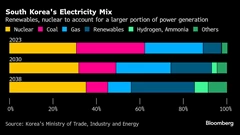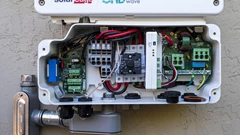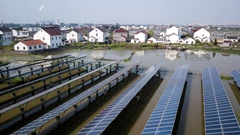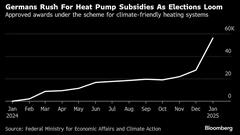Ailing Rooftop Solar Expects Boost From Lower Interest Rates
(Bloomberg) -- A long-awaited cut in interest rates has buoyed the outlook of the US residential solar market, which expects it to spur a wave of rooftop power installations.
The Federal Reserve on Wednesday lowered its benchmark rate by 50 basis points, a move that will make it less costly for consumers to finance residential solar projects that average about $30,000 each.
While lower rates will mean cheaper borrowing costs for the entire solar industry, and across the economy, residential solar has been particularly stung as rates climbed in the past two years.
About 85% of homeowners finance their rooftop projects, according to EnergySage Inc. But that only makes financial sense if the monthly outlay is competitive with their utility bills. Higher rates brought higher payments that made that equation harder to justify, according to Deep Patel, chief executive officer of Gigawatt Inc.
“That’s what has been holding the market back,” said Patel, whose Anaheim, California-based company designs rooftop systems for homes and businesses. He expects lower borrowing costs to spur sales among consumers who will now see lower monthly payments.
It’s a boost the market needs. Residential solar installations are expected to slump 19% this year, according to the Solar Energy Industries Association trade group. While local policy decisions have hindered installations in key states including California, persistently high interest rates have also been a drag on the market.
“This rate cut will save solar shoppers thousands of dollars in interest over the lifetime of their solar panels,” Spencer Fields, director of insights at EnergySage, said in a blog post Wednesday. “Dropping interest rates will help make solar more affordable and likely drive up demand.”
For example, cutting rates by 50 basis points means a $30,000 system would cost about $3,000 less over the course of a 20-year loan, according to EnergySage. The Boston-based company operates an online marketplace for solar.
Lower rates will also help developers of big solar projects but will be more important for consumers. Utility-scale projects involve multiple, complicated factors in addition to interest rates that affect the final cost, and they have greater economies of scale. But for smaller, residential systems, financing costs weigh more heavily on the end users — homeowners.
While it’s not clear how quickly the change will translate into sales, it will likely happen fast, according to Rob Barnett, a senior analyst at Bloomberg Intelligence. People calling for quotes on new projects should start to hear estimates that reflect the new rates almost immediately.
“This really shifts the underlying economics of projects,” said Barnett. “That should attract folks who have been mulling the idea.”
©2024 Bloomberg L.P.
KEEPING THE ENERGY INDUSTRY CONNECTED
Subscribe to our newsletter and get the best of Energy Connects directly to your inbox each week.
By subscribing, you agree to the processing of your personal data by dmg events as described in the Privacy Policy.
More renewables news

GB Energy Faces New Doubts as UK Declines to Affirm Future Funds

Korea Cancels Planned Reactor After Impeaching Pro-Nuke Leader

Brazil’s Net-Zero Transition Will Cost $6 Trillion by 2050, BNEF Says

SolarEdge Climbs 40% as Revenue Beat Prompts Short Covering

EU to Set Aside Funds to Protect Undersea Cables from Sabotage

China Revamps Power Market Rules In Challenge to Renewables Boom

KKR increases stake in Enilive with additional €587.5 million investment

TotalEnergies and Air Liquide partner to develop green hydrogen projects in the Netherlands

Germany Set to Scale Down Climate Ambitions
















